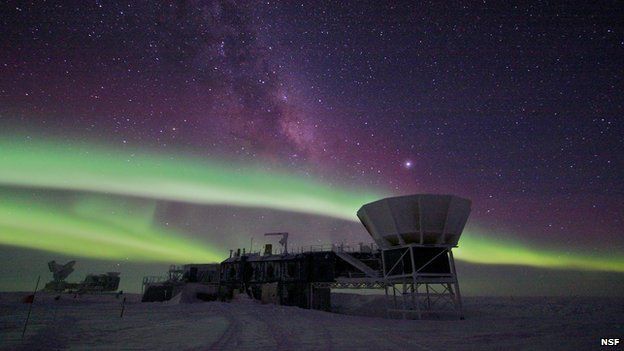Cosmic inflation: BICEP 'underestimated' dust problem
- Published

One of the biggest scientific claims of the year has received another set-back.
In March, the US BICEP team said it had found a pattern on the sky left by the rapid expansion of space just fractions of a second after the Big Bang.
The astonishing assertion was countered quickly by others who thought the group may have underestimated the confounding effects of dust in our own galaxy.
That explanation has now been boosted by a new analysis from the European Space Agency's (Esa) Planck satellite.
In a paper published on the arXiv pre-print server, Planck's researchers find that the part of the sky being observed by the BICEP team contained significantly more dust than it had assumed.
This new information does not mean the original claim is now dead. Not immediately, anyway.
Cosmic 'ripples'
The BICEP and Planck groups are currently working on a joint assessment of the implications, and this will probably be released towards the end of the year.
However, if the contention is eventually shown to be unsupportable with the available data, it will prove to be a major disappointment, especially after all the initial excitement and talk of Nobel Prizes.
What BICEP (also known as BICEP2) claimed to have done was find the long-sought evidence for "cosmic inflation".
This is the idea that the Universe experienced an exponential growth spurt in its first trillionth of a trillionth of a trillionth of a second.
The theory was developed to help explain why deep space looks the same on all sides of the sky - the notion being that a very rapid expansion in the earliest moments could have smoothed out any unevenness.
Inflation makes a very specific prediction - that it would have been accompanied by waves of gravitational energy, and that these ripples in the fabric of space-time would leave an indelible mark on the "oldest light" in the sky - the famous Cosmic Microwave Background (CMB).
The BICEP team said its telescope at the South Pole had detected just such a signal.
Cosmic 'ripples'
It is called B-mode polarisation and takes the form of a characteristic swirl in the directional properties of the CMB light.
But it is a fiendishly difficult observation to make, in part because the extremely faint B-mode polarisation from nearly 14 billion years ago has to be disentangled from the polarisation being generated today in our Milky Way Galaxy.
The main source of this inconvenient "noise" is spinning dust grains.
These countless particles become trapped and aligned in the magnetic fields that thread through our galaxy.
As a consequence, these grains also emit their light with a directional quality, and this is capable of swamping any primordial background signal.
The BICEP team's strategy was to target the cleanest part of the sky, over Antarctica, and it used every piece of dust information it could source to do the disentanglement.
What it lacked, however, was access to the dust data being compiled by Europe's Planck satellite, which has mapped the microwave sky at many more frequencies than the American team.
This allows it to more easily characterise the dust and discern its confounding effects.
The Planck report in the arXiv paper details dust polarisation properties across a great swathe of sky at intermediate and high galactic latitudes.
Only a very small portion of those fields is relevant to BICEP, but the results are not encouraging. There is significantly more dust in BICEP's "southern hole" than anticipated.
Indeed, most of the American signal - perhaps all of it - could have been attributed to dust.
"It's possible, but the error in our measurement is quite high," Planck scientist Dr Cécile Renault told BBC News.
"The conclusion really is that we need to analyse the data together - BICEP and Planck - to get the right cosmological [versus] galactic signal. It's really too early to say."
The American group had already downgraded confidence in its own result when it finally published a paper on the inflation claim in Physical Review Letters in June.
In the eyes of many commentators, the new Planck analysis will shake that confidence still further.
'Premature' announcement
The Planck researchers themselves promise to report back on their own search for a primordial polarisation signal very soon (probably at the same time as the joint paper with BICEP). Their approach is different to the American one
"Planck has wider spectral coverage, and has mapped the entire sky; BICEP2 is more sensitive, but works at only one frequency and covers only a relatively small field of view," explained Prof Peter Coles from Sussex University, who has been tracking the developing story on his blog, In The Dark.
"Between them they may be able to identify an excess source of polarisation over and above the foreground, so it is not impossible that a gravitational wave component may be isolated. That will be a tough job, however, and there's by no means any guarantee that it will work. We will just have to wait and see."
But what can be said now, adds Prof Coles, is that BICEP's March claim "was premature, to say the least".
Even if the American and European approaches turn out to be unsuccessful this time, these groups will have pointed the way for future observations that are planned with superior technology. Planck has actually now identified parts of the sky that have less dust than the area probed by BICEP.
"If you look at the maps we've produced, the more blue parts are where you should go look for the primordial signal," explained Dr Renault.
Jonathan.Amos-INTERNET@bbc.co.uk and follow me on Twitter: @BBCAmos
- Published3 July 2014
- Published20 June 2014
- Published17 March 2014
- Published17 March 2014
- Published27 March 2013
- Published21 March 2013
- Published18 March 2013
- Published20 September 2002